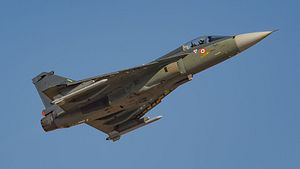India’s state-owned Hindustan Aeronautics Limited (HAL) concluded a deal on October 26 with Israel Aerospace Industries (IAI) subsidiary Elta Systems for the purchase of 83 ELM-2052 active electronically scanned array (AESA) radars and ELL-8222WB electronic warfare (EW) suites to be integrated with the Mark-IA Tejas Light Combat Aircraft (LCA), according to local media reports.
Elta was selected over two European defense contractors, Thales and Saab, to provide its systems to the Indian Air Force (IAF). The selection of Elta has been met with criticism by various Indian defense analysts. There is some concern that the IAF will not be able to procure the beyond-visual-range air-to-air (BVRAAM) Meteor missile for its fleet of Mark-IA LCA.
“MBDA, the European consortium that builds the Meteor, has repeatedly told the IAF that it would only fit that missile onto a fighter with a European airborne radar,” Ajaj Shukla wrote in the Business Standard earlier this week. “Choosing an Elta AESA radar for the Tejas Mark-IA, therefore, rules out the Meteor and, with it, any hope that the IAF will buy the Mark-IA in significant numbers.”
The IAF already is procuring the Meteor BVRAAM for its 36 Dassault Rafale fighter jets. Yet MBDA notified the Indian government that it would not integrate missile on any Israeli or Russian platforms. This could pose a problem for the combat effectiveness of the Tejas Mark-IA, an upgraded variant of the Tejas Mark-I featuring various upgrades including an AESA radar system, an EWI suite, and an externally refueling capability.
While the Tejas LCA is slated to be armed with the I-Derby BVRAAM, manufactured by Israeli defense contractor Rafael Advanced Defense Systems, the IAF stipulated in 2017 that the upgraded variant of the Tejas LCA must have the Meteor as well as MBDA’s Advanced Short Range Air-to-Air Missile (ASRAAM). For one thing, the I-Derby’s range — the extended range variant of the weapon can engage targets up to a distance of 100 kilometers — cannot match the 200 to 250-kilometer range of the Meteor.
The Indian Ministry of Defense (MoD) has ordered 40 Tejas LCA Mark-I with HAL. 16 Tejas LCA in initial operational configuration — 12 fighters and four trainers — have been produced so far. Notably, the the aircraft maker has failed to meet the eight aircraft per annum quota. Despite of that the MoD agreed to place an order for 83 additional Tejas LCA–73 single-engine Tejas LCA Mark-IA, and 10 tandem two-seat LCA trainer aircraft—with HAL. However, a prerequisite for the Mark-IA order is that the aircraft receive the Meteor.
Consequently, it remains unclear whether the Mark-IA will ever see service with the IAF. At the same time, the Tejas Mark-I has yet to achieve final operational clearance by the Indian Aeronautical Development Agency.

































